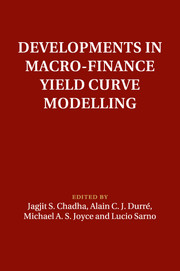Book contents
- Frontmatter
- Contents
- List of figures
- List of tables
- List of contributors
- Foreword
- Preface
- 1 Editors' introductory chapter and overview
- Part I Keynote addresses
- 2 Is the long-term interest rate a policy victim, a policy varible or a policy lodestar?
- 3 Sovereign debt and monetary policy in the euro area
- 4 The Federal Reserve's response to the financial crisis: what it did and what it should have done
- 5 Tail risks and contract design from a financial stability perspective
- Part II New techniques
- Part III Policy
- Part IV Estimating inflation risk
- Part V Default risk
- Index
2 - Is the long-term interest rate a policy victim, a policy varible or a policy lodestar?
from Part I - Keynote addresses
Published online by Cambridge University Press: 05 February 2014
- Frontmatter
- Contents
- List of figures
- List of tables
- List of contributors
- Foreword
- Preface
- 1 Editors' introductory chapter and overview
- Part I Keynote addresses
- 2 Is the long-term interest rate a policy victim, a policy varible or a policy lodestar?
- 3 Sovereign debt and monetary policy in the euro area
- 4 The Federal Reserve's response to the financial crisis: what it did and what it should have done
- 5 Tail risks and contract design from a financial stability perspective
- Part II New techniques
- Part III Policy
- Part IV Estimating inflation risk
- Part V Default risk
- Index
Summary
2.1 Introduction
It is an excellent idea to focus a conference about ‘what have we learnt from the 2007–2010 financial crisis’ on the yield curve. It is an excellent idea because one end of that curve – the long-term rate of interest – has fallen so low that serious questions about monetary policy frameworks and financial stability risks are inescapable.
Because it is a lodestar for the financial industry and for many government policies, it would be reassuring to imagine that the real long-term interest rate is determined by the market. We would like to think that fundamentals such as the underlying saving and investment propensities of the private sector (and the corresponding ‘habitat’ preferences of investors) play the dominant role. All appearances suggest a vibrant market: interest rates markets are among those most heavily traded and prices are indeed very responsive to changes in economic conditions.
Yet there is a major difficulty: the aggregate impact of many official policies – taking quite different forms – has been to increase the demand for government bonds, particularly those in key international currencies. The long-term interest rate can then become a victim of such policies. How far this reflects a motivation for such policies is an open question; but governments with massive debts to finance obviously welcome low long-term rates.
- Type
- Chapter
- Information
- Developments in Macro-Finance Yield Curve Modelling , pp. 19 - 55Publisher: Cambridge University PressPrint publication year: 2014
- 2
- Cited by

